Himachal - Land of Gods
Nestled in the Himalayas, the world's mightiest mountain ranges, Himachal Pradesh is blessed with some of the most spectacular and beautiful landscape anywhere, it is traveller's paradise- mighty snow peaks, deep gorges, lush green valleys, misty woods, fast flowing rivers, enchanting lakes and flower filled meadows. Its high mountains and valleys are linked by winding roads and high passes. While the picturesque valleys of Kullu and Kangra are a riot of colours, in marked contrast the stark and barren terrain of Lahaul & Spiti have stunning lunar and scape like beauty.
CITIES IN HIMACHAL PRADESH
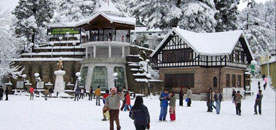
Shimla :
Shimla is the capital town of Himachal Pradesh. The town of Shimla is built over several hills and connecting ridges. The important hills are Jakhu ( 2,455 meters ), Prospect Hill ( 2,328 meters ), Observatory Hill ( 2,350 meters ), Elysigim Hill ( 2,466 meters ) and Summer Hill ( 2,300 meters ). Shimla is situated in the North-West Himalayas and was the Summer Capital of India during the British rulling era. This town is spread over the ridge measuring about 12 km. It is perhaps the biggest hill station in the world, located at an altitude of 2,421 meters above sea level. A place of peace and pleasure, Shimla is a tourist resort in real sense of the world. 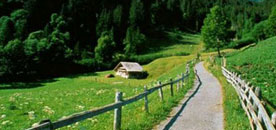
Manali :
Just 40 kms away from Kullu to the north, Manali is situated near the end of the valley on the National Highway leading to Leh. The landscape here is breath taking. One sees well-defined snow capped peaks, the Beas river with its clear water meanders through the town. On the other side are deodar and pine trees, tiny fields and fruit orchards. It is an excellent place for a holiday, a favorite resort for trekkers to Lahaul, Spiti, Bara Bhangal (Kangra), and Zanskar ranges. From temples to antiquity, to picturesque sight-seeing spots and adventure activities, Manali is a popular resort for all seasons and for all travellers.
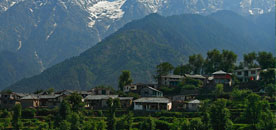
Dharamshala :
Dharamshala, at an altitude of 4000 m above sea level, it is located on spur of Dhaulandhar range. The town has rich growth of deodar and pine forests as well as tea gardens. Dharamshala literally means 'the holy refuge'. It was founded and developed by the British in 1855 as their summer resort. It is famous as the abode of the Dalai Lama and is called as the "Little Lhasa' because of the large number of Tibetan population. Their 'Government in Exile' has headquarters in Dharamshala. 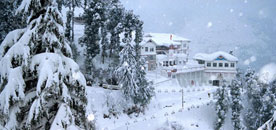
Dalhousie :
Located in the outer slopes of hill Dhauladhar range is another important hill resort in the district Chamba . A number of picturesque walks run through the oak, pine and deodar forests around the town and offer excellent views of the Chenab, the Ravi and the Beas valleys. It is thicky wooded with stately pines and oaks and has lovely picnic spot all around. Dalhousie is the gateway to Chamba. Originally conceived as a sanitorium by its founder Lord Dalhousie, it is today one of the most quiet hill stations. Extending over an area of 13 sq. km., Dalhousie comprises five distinct hills, Balun, Kathlog, Petreyn, Tehra and Bakrota with heights ranging between 1,525 and 2,378 metres. 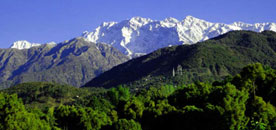
Palampur :
The town of Palampur (1219 m) is situated in a idyllic valley priding itself with tea gardens, and hills covered with pine trees. The place enjoys a year-round pleasant climate and the pine scented air is said to have curative properties. The scenery presents a sublime and beautiful contrast- the valleys presents a picture of rural innocence and repose, while the hills are majestic. Overlooking this town are the majestic Dhauladhars, whose tops remain covered with snow for most of the year. This place is thronged tourists and is now being developed as a large tourist centre. 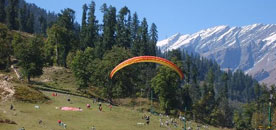
Solang Valley :
Blessed with a pleasant climate all the year round. Solang is a district headquarter and has the famous temple of Shoolini Devi and from Solan the Jatoli village (15 km) and the temple of Lord Shiva and on Rajgarh road the Buddhist Monastery (18 km) may be visited. Known as the "Mushroom city of India" Solan has an old brewery (11 km) and a sprawling horticulture and forestry university at Nauni (16 km). HPTDC hotel at Barog and other pvt hotels & restaurant are available at Solan. 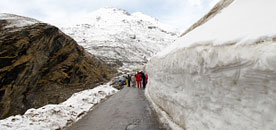
Rohtang Pass :
A few kilometers from Manali is the Rohtang Pass, a place known for the divergent landscapes. You will find the rich greenery of the Kullu valley along with bare, brown mountains, glaciers and snowfields. The place looks lovely in the crisp sunlight. The Rohtang Pass lies in the district of Lahaul and Spiti. Due to its difficult terrain, not many tourists have ventured into this region. The place is untouched by the outside world of modernity. PILGRIMAGES IN HIMACHAL
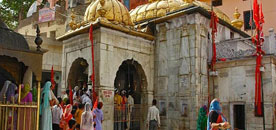
Jwalaji Temple :
One of its own kinds of temples, there is no idol in it. An eternally burning and shining blue flame emanating from a rock sanctum is only worshipped here as a manifestation of the goddess. Dedicated to the deity of Flaming Mouth or goddess Jwalaji, the temple is one of the 51 power spots or Shaktipeethas of India. One of the most revered temples of the Hindus, the temple possesses a golden dome, gifted by Mughal Emperor Akbar. The temple is at its best during Navratri festival in early April and mid October. 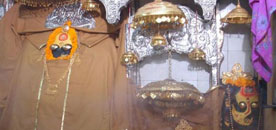
Naina Devi Temple :
Surrounded by Govind Sagar Lake and Bharka Dam, the Naina Devi temple at Bilaspur is about 15 kms from Ganguwal and about 18-km from Anandpur Sahib. Like most of the Indian Shaktipeethas in the country, the origin of this famous and one of the most revered shrines also dates back to the self-immolation of 'Sati.' Nanina Devi as the name suggests is believed to be the place where the eyes of Sati fell. 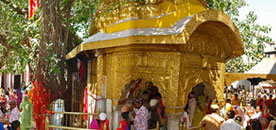
Chintpurni Temple :
Situated at the altitude of 940 meters, the temple rests on one of the highest peaks of the Sola Singhi range of hills. About 3 km west of Bharwain, on the Hoshiarpur - Dharmashala road, the temple remains open from 4am to 11pm. People reach the shrine after walking around half a km up a gentle incline and making their way through a very busy market. There is a garbha griha at the centre of the main temple where the image of Mata Chintpurni Devi is installed in the form of a round stone, also known as a 'Pindi'. People stand in queues to get a look of the deity and offer prayers. It is a popular belief here that the goddess always fulfills the wishes made from a pure and true heart. 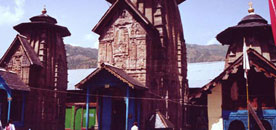
Laxmi Narayan Temple :
One of the largest and the oldest temples at Chamba stands proudly in the form of Lakshmi Narayan Temple. Housing six different temples in its complex, the temple was built in the 10th century. Arranged from north to south, all the temples in the complex are dedicated to either Lord Shiva or Vishnu. Some additional temples are also housed in the complex including Radha Krishna Temple, Shiva Temple of Chandragupta and Gauri Shankar Temple. 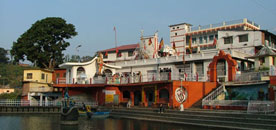
Chamunda Devi Temple :
Overlooking the mighty Dhauldhar ranges, the Chamunda Devi Temple is situated on the bank of river Ban Ganga, at 1000m above sea-level. Located at about 15 kms from Dharamshala, this ancient temple is 700 years old. Also known as Chamunda Nandikeshwar Dham; this sacred temple is an abode of Shiva- the destroyer God and Shakti- the goddess of power since the saga of Puranas.
The temple comprises of a big complex with a 'Kund' (pond) in it. The devotees take a holy dip in this pond. Due to its utterly sacred importance, the main deity of the temple is not accessible to the visitors, being kept under cover. A cave-like scoop at the back of the temple represents an embodiment of Shiva, the stone lingam. 